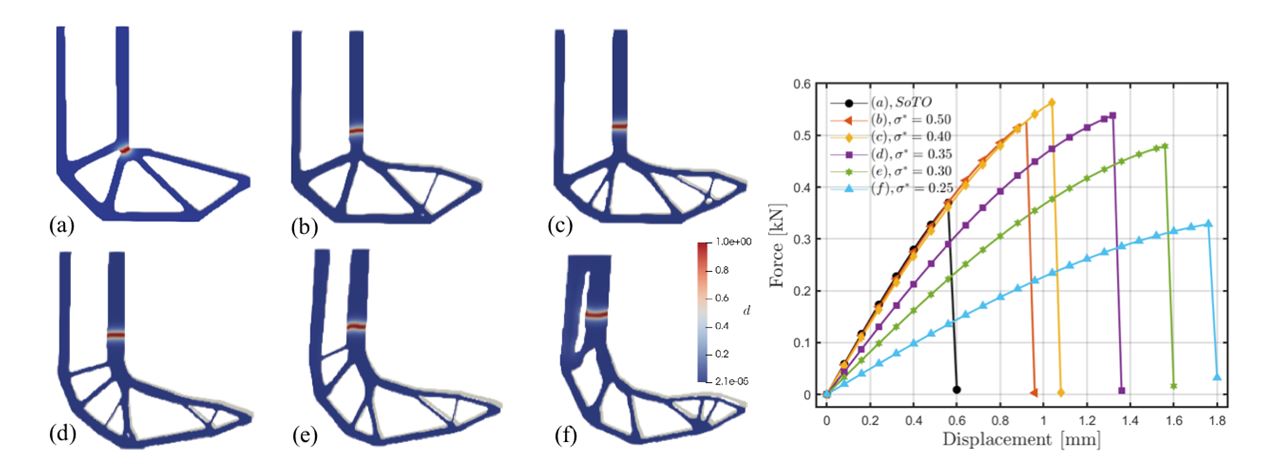Video Article Open Access
Data-driven and Topological Design of Structural Metamaterials for Fracture Resistance
Daicong Da*, Wei Chen
Department of Mechanical Engineering, Northwestern University, Evanston, IL 60201, USA
Vid. Proc. Adv. Mater., Volume 2, Article ID 2021-02147 (2021)
DOI: 10.5185/vpoam.2021.02147
Publication Date (Web): 30 Mar 2021
Copyright © IAAM
Graphical Abstract

Abstract
Toughness and strength are two conflicted material properties. Strong materials are often brittle while lower strength materials tend to be tougher. From an intrinsic perspective, this work aims to improve both toughness and strength of brittle structural materials through precise control of local stress and combining topological optimization and machine learning techniques. First, a mixed topology optimization (mixed TO) is proposed to maximize the strain energy under displacement load, while a maximum threshold is imposed on the local stress as a constraint [1]. Fracture response is tailored and compared between optimized structural materials by setting the threshold and by adopting the phase field modelling. Both structures consisting of a single material and stiff-and-soft composite are studied. For single material design, the mixed TO results can achieve maximally 6 times tougher and more than 1.5 times stronger compared with the stiffness-only result. In two-phase composite design, numerical experiments evidence also significant enhancement, more than 2.5 times in toughness and more than 10% in strength, compared with the homogeneous strongest constitutive materials in the case of non-pre-notch and the Mode-I failure. Against to stress-only optimization, all concerned mechanical properties including stiffness, toughness, and strength can be improved by more than 15% simultaneously. Secondly, we propose a data-driven design framework for fracture resistance of the metamaterial with aperiodic microstructures. A deep neural network model consisting of a variational autoencoder (VAE) and a regressor for property prediction is trained and served as the database [2]. The latent space of the constructed VAE enables easily manipulation between different types of microstructures and can generate new ones with tailored material properties. Thereafter, it is integrated in a topology-like distribution optimization for each component of the effective material elastic matrix. Finally, macroscopic global structure can be assembled by the target unit cells in the constructed database based on the optimal distribution of the material properties. Consistency between different unit cells will be guaranteed via a graph-based optimization method. We show that significant enhancement of the fracture resistance can be achieved for the considered porous structures by the present method [3].
Keywords
Data driven; topological design; aperiodic microstructures; stress; fracture resistance.
Acknowledgement
Support from the NSF CSSI program (Grant No. OAC 1835782) is greatly acknowledged.
References
- D. Da, Tailoring fracture properties of brittle structural materials. (Under review).
- L.Wang, Y.C. Chan, F. Ahmed, Z. Liu, P. Zhu, W. Chen, Computer Methods in Applied Mechanics and Engineering, 2020, 372,113377.
- D. Da, L.Wang, Y.C. Chan, W. Chen, Data-driven design of aperiodic metamaterials for fracture resistance. (in preparation).
Biography
Daicong Da is a postdoctoral fellow at Northwestern University, United States. He received his Ph.D. from the Université Paris-Est, France in 2019. Before joining Northwestern, he was a Research Associate at the University of Wisconsin-Madison, United States. His main research interests deal with material and structural design, optimization, multiscale methods and fracture modeling in heterogeneous materials, with applications to additive manufacturing and bioinspired composites. He is the author of 15+ papers in international journals, one monography and more than 20 communications in international and national conferences.
Video Proceedings of Advanced Materials

Upcoming Congress



